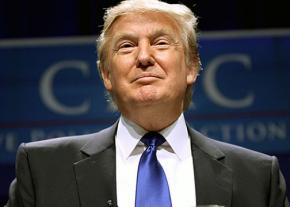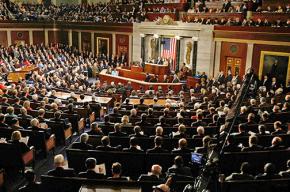Live coverage on Election Night
Welcome to SocialistWorker.org's live coverage of Election 2016. We'll be posting analysis and commentary throughout the night as the results come in. You can follow our coverage at SW's Facebook page, and share your own observations and analysis in the comments section. Or read through the night's post here on the SW website. All times are Eastern.
12:30 a.m. | How could it happen?
By Lee Sustar | Why? How? Those questions are dominating the mainstream media as they take stock of Donald Trump's strong showing and possible--even likely--victory in the presidential race.
They are dominating us at SocialistWorker.org, and no doubt our readers, too. It is hard to come to terms with the upside-down results we are seeing. But here are some thoughts.
The opinion polls and big-data analysis pointed to the conclusion that Hillary Clinton was ahead by a narrow but significant margin in the popular vote, and in enough states to win a majority in the Electoral College--the archaic 18th-century institution that actually decides who the president is.
Clinton is still expected to win the popular vote, and in an actual democracy, that would be the end of the matter. But at this point, she is behind or defeated in key states that are likely to give Trump a win in the Electoral College.
It's a staggering turn of events--and if Trump wins, it will upend politics in the U.S. and internationally in ways we can't explore now.
But the "why" of Trump's success--or rather, Clinton's failure--is already clear. Having abandoned the Democratic Party's more liberal base to chase traditionally Republican-voting suburbanites, Clinton left the field open to Trump to claim that his reactionary program would benefit ordinary people who have seen their living standards stagnate and decline even in the period of "recovery" from the Great Recession.
Trump's promises are lies--a pro-worker camouflage for helping the 1 Percent with gigantic tax giveaways and the like. But Clinton's promise of continuing an intolerable status quo didn't sound like a real alternative to people at the end of their rope.
Bernie Sanders' left-wing campaign for the Democratic presidential nomination nearly upset Clinton by making an appeal to workers to challenge what he called the "billionaire class." Clinton, who has spent her political career ingratiating herself to that class, buried Sanders' message--and Sanders abandoned any opposition after he endorsed Clinton. Trump could thus continue almost unchallenged with his agenda of channeling legitimate economic grievances into racist scapegoating.
Even when Clinton tried to counter Trump's racist, woman-hating, immigrant-bashing and Islamophobia, it rang hollow. As a personification of the political establishment, Clinton bears responsibility--often directly--for policies that led to the mass incarceration of African American men, the sweeping deportation of immigrants and the endless wars in Afghanistan and Iraq that have fueled anti-Arab and anti-Muslim bigotry.
There's much more to be said about Election 2016, and even more discussion that needs to take place about confronting the ramifications of what seems more likely than not to be a Trump presidency.
But what we can say now is that Trump's showing has highlighted the urgent need for left-wing movements and political organizations independent of a dysfunctional two-party system that produced this dreadful election.
10 p.m. | Minimal support from Hillary Clinton
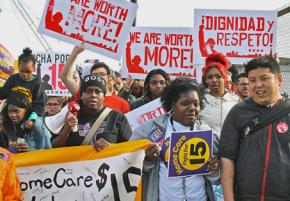
By Elizabeth Schulte | An increase in the minimum wage is up for a vote in Washington state, one of a small handful of states that had referendums like this on the ballot (not counting the proposed hard-to-believe decrease in the minimum wage for workers under the age of 18 in South Dakota.).
The Washington increase is modest--a gradual increase from $9.47 an hour today to $13.50 an hour by 2020--but solid support for the referendum in opinion polls reflects greater recognition of the fact that millions of workers trying to feed their families on the minimum wage.
Thanks to protests led by fast-food and retail workers that was growing a few years ago, the demand for $15 an hour went from being demand that a growing number of the public could get behind. Unfortunately, this struggle has been overshadowed by the presidential election campaign and the priority for unions of trying to get a Democrat in the White House.
Hillary Clinton doesn't support a $15 federal minimum wage, even though she counts on the support of minimum-wage workers and unions to elect her as president.
Granted, Clinton hasn't exactly broadcasted this fact. One of the leaked e-mails from campaign manager John Podesta revealed how the Clinton team tried to pretend they supported the higher minimum wage, but not one as high as $15. They debated until they came up with "something creative to support efforts without coming out for a number," as one adviser said. After fiercely debating about whether to include the hashtag #FightFor15 in a tweet on a day of action--organized by Fight for 15--in April, Clinton advisors decided against it.
The movement of low-wage workers that put the demand for $15 an hour on the table will have to be ready to take the streets again--because Hillary Clinton isn't doing anything unless she feels real pressure.
8:25 p.m. | Their working class and ours
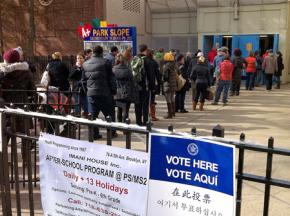
By Elizabeth Schulte | "We've lost touch with working-class voters." That was Joe Biden's message in an interview with Hardball's Chris Matthews, issuing a warning that's been heard again and again from politicians and pundits about what they believe is Donald Trump's source of support.
But I wouldn't get too excited about Washington and its media echo chamber deciding to start focusing on the concerns of U.S. workers.
When they say "working class," they don't mean what we mean by "working class"--they mean Trump supporters. It's the only way for the political and media establishment to understanding Donald Trump's rise--with a myth that there are ignorant white workers out there waiting for some racist demagogue to show them the way. That's how condescending the people in charge of the "political discourse" are.
If you want to talk about who supports Trump, you're actually looking at a section of the population that's more affluent than those who supported Hillary Clinton or Bernie Sanders. According to an analysis of exit poll data during the primaries by FiveThirtyEight.org, the median annual household income of a Trump voter was $72,000, compared to $61,000 for Clinton and Sanders supporters.
Really understanding Trump's appeal requires looking more closely at how eight years of a Democrat in the White House has left a large part of the population embittered with their declining living standards.
Oh yeah, and here's another wild fact for Biden and the talking heads on the political talk shows: The U.S. working class isn't made up of just white men. It's actually disproportionately composed of women, Blacks, Latinos, Muslims, immigrants and young people.
You know who I mean: People who work for a living, unlike Biden or Chris Matthews, and who are also target of Trump's scapegoating attacks. They're also the people, along with white working-class men, who have the power to stop Trumpism.
But as long as we're on the subject, the Democratic and Republican parties have lost touch with the working class. From Clinton's insistence that America is "already great" to an election that has demonstrated that money and power call the shots in Washington, millions of people understand that there's a big gap between the concerns of mainstream politics and the concerns of working people.
The only antidote is to stop supporting their parties and build organizations that press for our demands.
7:40 p.m. | Will the Democrats take Congress? Does it matter?
By Alan Maass | There was a time back in October, with the Trump campaign crumbling after the candidate was exposed as a serial sexual assaulter, that Democrats dreamed of a landslide election giving them control over Congress to go with the White House.
Cold reality has intruded.
The Democrats never really had a chance to flip the House of Representatives, where the current split is 247 Republican seats to 188 Democratic seats.
One reason for the long odds is the outrageous gerrymandering of congressional districts, mainly by Republican state legislatures. But remember that the U.S. House of Representatives has always had a lower turnover rate than the ex-USSR's Supreme Soviet at the height of Stalinism. This year, only 37 races out of 435 seats are rated as "competitive", with the Democrats predicted to pick up 20 seats at most.
The Senate is closer. Democrats need four more seats for a 50-50 split and five to have a majority again--and a couple likely pickups in Illinois, Wisconsin and Pennsylvania. Check out FiveThirtyEight.com for the details, but the bottom line: Keep your eye on races in Missouri, Nevada and New Hampshire that are all toss-ups, according to opinion polls. If Democrats can win two of three, they probably get the majority back.
The media will report on the Senate horse race breathlessly all night. But don't think that the future of revived liberalism depends on it.
Both Bill Clinton and Barack Obama had Democratic control over both houses of Congress for the first two years of their presidencies, and both dashed the expectations of their supporters.
Clinton had promised that passage of a striker replacement ban would be a top priority, but he and the Democrats didn't lift a finger on that legislation. They did, however, rely on Democratic votes to pass the North American Free Trade Agreement.
Barack Obama said he would enact "comprehensive immigration reform" within his first year as president, and he even had significant Republican support for an enforcement-heavy, highly restrictive measure. But Obama didn't fight either.
Another question to keep in mind when you hear about the battle over control of the Senate: Who are the Democrats running to win back the majority?
In Missouri, the Senate nominee is Jason Kander, who never fails to remind audiences that he VOLUNTEERED to fight in Afghanistan--and whose best-known campaign stunt was a video showing him assembling an AR-15 assault rifle while blindfolded, as he explains that he supports background checks on gun buyers "so terrorists don't get their hands on one of these."
Doesn't seem like a likely candidate to join the Elizabeth Warren/Bernie Sanders wing of the Democratic Party.
7 p.m. | The 270 votes that really matter
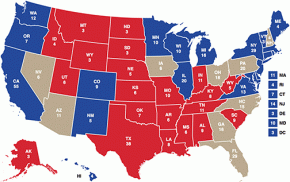
By Lance Selfa | If you're settling in for the evening, think of this first post as a primer on how someone wins the presidency. Because in the "world's greatest democracy," it's not so simple as getting the most votes.
The outcome of the presidential election, as you probably know, is determined not by the popular vote, but the Electoral College--a relic of the 18th century to protect the power of slave owners that today gives extra influence to less populous, rural states.
There are a total of 538 electors in the Electoral College, determined by which candidate wins in each state, so presidential campaigns are about getting to half plus one: 270 electoral votes by whatever combination of states. That's why presidential elections come down every four years to a battle over 10 to 12 states most closely divided between the parties--not all 50. Sorry California and New York, but you're taken for granted.
These days, the Republicans can count on winning 20 to 22 mostly rural or resource-extracting states in the South, Plains and Mountain West. The Democrats rely on the "blue wall" of 18 states and the District of Columbia in the Northeast, on the Pacific Coast and in the Upper Midwest, which the party has won in every presidential election since 1992.
If traditional patterns hold--and there's little polling evidence to show they won't--the Democrats' "blue wall" will get Clinton to 242 electoral votes. She only needs a couple battleground states to get over the top, and polls show here leading all the way through the campaign in a few, like Colorado and Virginia. Because the GOP starts out from a base of, at most, 158 electoral votes, Trump can only win if he "runs the table."
In the next few hours, the media will be hyping the "too close to call" states, but we should have a good idea of how the election will end up in the hour after 8 p.m. Eastern, if not before.
The states to watch are Florida, North Carolina, Ohio, Pennsylvania and New Hampshire. Trump has to pretty much sweep these states to have a chance at getting to 270. That's a tall order--opinion polls show all of them are close, but only in Ohio has Trump had a consistent lead. Clinton, on the other hand, has a cushion--theoretically, she could lose Florida, North Carolina and Ohio, and still win a majority of the Electoral College.
If Pennsylvania and New Hampshire go for Trump early, the Democrats are in big trouble--Pennsylvania hasn't voted Republican in a presidential election since 1988, and New Hampshire has been reliably Democratic on the presidential level since the 1990s. But if Clinton gets an early call in Florida or North Carolina, that would be a sign that she'll win in the Electoral College by a wider margin.
And for those of you feeling some frustration that your vote doesn't seem to matter because you live in a non-swing state, you can blame the damn slave owners.

